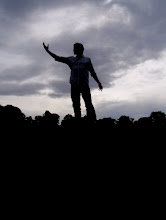let others wear the sackcloth and the ashes.
Let go, let fly, forget.
Okay, howdy howdy howdy. Sorry it’s taken me a year to get back to this, but it has been a fun, busy start to a new term. I would like to begin by thanking all of the people who commented via e-mail, facebook and carrier pigeon. It was really nice to hear other’s views regarding humanity’s (and Humanities’) place in medicine. I would like to especially thank “Swampstorm” for the detailed reply in the comments section. Being relatively new to the whole blogosphere (ugh…portmanteaux like that make me cringe)… “The Land of Blogs”…I must say that I was rather chuffed to see that people (outside my immediate family –love ya mum!) actually read this stuff. I will endeavor to continue the dialogue that Swampstorm took up. I will also try to throw up (perhaps poor phrasing) some photos to keep this from getting too serious. As always, I encourage comments – here or elsewhere; let me know what you want to hear about, and in a year or two I’ll address them.
So, to start at the end: Swampstorm asked the significance of the introductory image: Holbein’s “Ambassadors.” It is an image I find quite intriguing. There are the obvious ties between the sciences and arts (various cartographic paraphernalia and the lute on the shelves). But it is also fitting in its use of the anamorphic image in the foreground. The light blotch, at first mistakable for a stain, when viewed from the extreme left side (try it on your computer!) becomes a skull. I was really just using it to emphasize the need to look at things from different angles: medicine especially.
After reading your comment, Swampstorm, and re-reading my last post I recall that my intent there was to frame the omnipresent matter that I strive to take up (Humanities in Medicine) in a confrontational manner (Humanities vs. Medicine). My goal was to spark a bit of discussion (and as I said I am thrilled with the conversations that ensued) but by framing my post in this manner, perhaps the segue into my true intention (highlighting the importance of coalescing Humanities and Medicine) ebbed.
I like your introductory point about humanities embracing a marginalized position. Where humanities are on the fringe it is often quite accurate that groups will adopt (“with masochistic relish”) the role of underdog. I enjoy your Althusserian reading of humanities constructing itself upon the Ideological State Apparatus of resistance against science (now even the English major in me is wincing). Sorry to bog this blog down with theoretical jargon, but basically just referring to the idea that established social practices (like the media, education, science etc.) impose a role on people. To take this ratiocination a wee bit further: Althusser speaks of Repressive State Apparatuses which are invoked when groups pose a threat to the dominant order. This idea provides a fun (if slightly paranoid) interpretation of Campbell’s 90% cuts to the arts in British Columbia.
Now for something completely different:
As most of you know, my girlfriend Lise has moved out here for the term for a drop of the Irish sunshine. Despite living in a 10X10 (centimeter) cubical cubicle we’re having a grand aul’ time! I’ve had a new opponent to beat at scrabble (in my dreams anyway) and someone to unload the contents of my brain upon (hence the lack of writing here). She’s also been a wee dote in helping me prepare for the OCASE (Oh-Casey) we had last week.
Me winning in Scrabble
Galway by day...
...and by night.
The OCASE (forget what it stands for) is a clinical skills exam with 12 stations and 6minutes for each station to perform a skill that would normally take three times that amount of time. The stations required us to: walk through the curtain and almost into the director of paramedic training for Ireland who dropped a manikin in front of me and said “this man has just collapsed, you are the only person around – GO!” After six sweaty minutes of CPR I hustled to the next station and behind curtain number two was a rubber pelvis that I was to perform a pap smear and bimanual exam upon. Even after ripping three gloves (in half) I just managed to creep in under the time limit, without traumatizing anyone – whew! The exam was even complete with three “rest stations” to pace and contemplate all the things you’d forgotten up to that point. The rest of the hour and half was filled with similar adrenalin-inducing mayhem, I was just glad we didn’t have one of the stations that was apparently on last year’s OCASE: walk into the station to one of the deans of our school (mid-sixties, prestigious doctor) sitting behind a desk with a big red dildo on it and having to spend the next 6 minutes explaining how to put it on. Sometimes six minutes flies…and sometimes it doesn’t.
...But man, by eleven o’clock the top image sums up how we all felt.





No comments:
Post a Comment